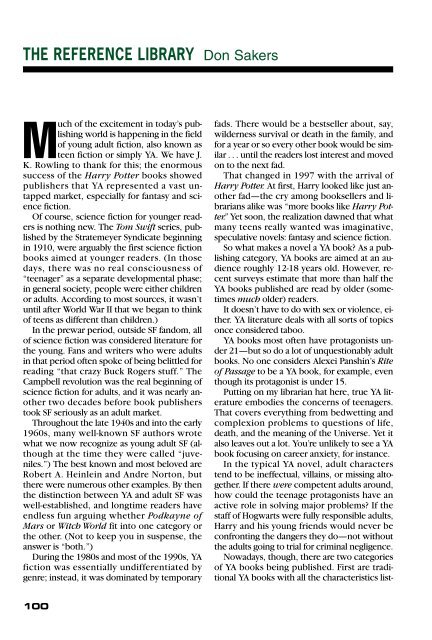Analog Science Fiction and Fact - June 2013
Analog Science Fiction and Fact - June 2013
Analog Science Fiction and Fact - June 2013
Create successful ePaper yourself
Turn your PDF publications into a flip-book with our unique Google optimized e-Paper software.
THE REFERENCE LIBRARY Don Sakers<br />
Much of the excitement in today’s publishing<br />
world is happening in the field<br />
of young adult fiction, also known as<br />
teen fiction or simply YA. We have J.<br />
K. Rowling to thank for this; the enormous<br />
success of the Harry Potter books showed<br />
publishers that YA represented a vast untapped<br />
market, especially for fantasy <strong>and</strong> science<br />
fiction.<br />
Of course, science fiction for younger readers<br />
is nothing new. The Tom Swift series, published<br />
by the Stratemeyer Syndicate beginning<br />
in 1910, were arguably the first science fiction<br />
books aimed at younger readers. (In those<br />
days, there was no real consciousness of<br />
“teenager” as a separate developmental phase;<br />
in general society, people were either children<br />
or adults. According to most sources, it wasn’t<br />
until after World War II that we began to think<br />
of teens as different than children.)<br />
In the prewar period, outside SF f<strong>and</strong>om, all<br />
of science fiction was considered literature for<br />
the young. Fans <strong>and</strong> writers who were adults<br />
in that period often spoke of being belittled for<br />
reading “that crazy Buck Rogers stuff.” The<br />
Campbell revolution was the real beginning of<br />
science fiction for adults, <strong>and</strong> it was nearly another<br />
two decades before book publishers<br />
took SF seriously as an adult market.<br />
Throughout the late 1940s <strong>and</strong> into the early<br />
1960s, many well-known SF authors wrote<br />
what we now recognize as young adult SF (although<br />
at the time they were called “juveniles.”)<br />
The best known <strong>and</strong> most beloved are<br />
Robert A. Heinlein <strong>and</strong> Andre Norton, but<br />
there were numerous other examples. By then<br />
the distinction between YA <strong>and</strong> adult SF was<br />
well-established, <strong>and</strong> longtime readers have<br />
endless fun arguing whether Podkayne of<br />
Mars or Witch World fit into one category or<br />
the other. (Not to keep you in suspense, the<br />
answer is “both.”)<br />
During the 1980s <strong>and</strong> most of the 1990s, YA<br />
fiction was essentially undifferentiated by<br />
genre; instead, it was dominated by temporary<br />
100<br />
fads. There would be a bestseller about, say,<br />
wilderness survival or death in the family, <strong>and</strong><br />
for a year or so every other book would be similar<br />
. . . until the readers lost interest <strong>and</strong> moved<br />
on to the next fad.<br />
That changed in 1997 with the arrival of<br />
Harry Potter. At first, Harry looked like just another<br />
fad—the cry among booksellers <strong>and</strong> librarians<br />
alike was “more books like Harry Potter.”<br />
Yet soon, the realization dawned that what<br />
many teens really wanted was imaginative,<br />
speculative novels: fantasy <strong>and</strong> science fiction.<br />
So what makes a novel a YA book? As a publishing<br />
category, YA books are aimed at an audience<br />
roughly 12-18 years old. However, recent<br />
surveys estimate that more than half the<br />
YA books published are read by older (sometimes<br />
much older) readers.<br />
It doesn’t have to do with sex or violence, either.<br />
YA literature deals with all sorts of topics<br />
once considered taboo.<br />
YA books most often have protagonists under<br />
21—but so do a lot of unquestionably adult<br />
books. No one considers Alexei Panshin’s Rite<br />
of Passage to be a YA book, for example, even<br />
though its protagonist is under 15.<br />
Putting on my librarian hat here, true YA literature<br />
embodies the concerns of teenagers.<br />
That covers everything from bedwetting <strong>and</strong><br />
complexion problems to questions of life,<br />
death, <strong>and</strong> the meaning of the Universe. Yet it<br />
also leaves out a lot. You’re unlikely to see a YA<br />
book focusing on career anxiety, for instance.<br />
In the typical YA novel, adult characters<br />
tend to be ineffectual, villains, or missing altogether.<br />
If there were competent adults around,<br />
how could the teenage protagonists have an<br />
active role in solving major problems? If the<br />
staff of Hogwarts were fully responsible adults,<br />
Harry <strong>and</strong> his young friends would never be<br />
confronting the dangers they do—not without<br />
the adults going to trial for criminal negligence.<br />
Nowadays, though, there are two categories<br />
of YA books being published. First are traditional<br />
YA books with all the characteristics list-

















